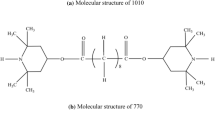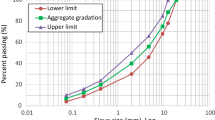Abstract
In this paper, dry–wet cycle aging method was applied to simulate the aging process in the presence of water. The SBS-modified asphalt binder (SBSMA) with different contents of SBS modifier was used for thermal oxygen aging (TOA) and dry–wet cycle aging (DWCA) for 30 days. The results show that the aging time, water and the dosage of SBS modifier had a significant impact on the physical properties of SBSMA. The results show that the aging time, water and the dosage of SBS modifier had a significant impact on the physical properties of SBSMA. After DWCA for 30 days, the penetration ratio (PR) and softening point ratio (SPR) values of SBSMA were higher than that of base asphalt binder by 26.8–29.2% and 5.3–18.5%, respectively. In contrast to TOA, the ductility retention rate (DRR) values of SBSMA under DWCA were more obvious. When the SBS content exceeded 4.5%, the variation range of SBSMA’s viscosity after DWCA became weaker than that after TOA. The results of Fourier transform infrared spectroscopy (FTIR) and X-ray photoelectron spectroscopy (XPS) show that there were slight drops by 8.9–28.8% and 3.3–13.9% in the contents of carbonyl and sulfoxide functional groups of 4.0–5.0% SBSMA after DWCA compared with those after TOA, due to the scouring effect of water on hydrophilic oxygen-containing functional groups. Moreover, the consumption of butadiene functional groups in SBSMA fluctuated at 20% with the SBS content rose.














Similar content being viewed by others
References
Chen J, Huang CC (2007) Fundamental characterization of SBS-modified asphalt mixed with sulfur. J Appl Polym Sci 103:2817–2825. https://doi.org/10.1002/app.24621
Fu H, Xie L, Dou D (2007) Storage stability and compatibility of asphalt binder modified by SBS graft copolymer. Constr Build Mater 21:1528–1533. https://doi.org/10.1016/j.conbuildmat.2006.03.008
Yildirim Y (2007) Polymer modified asphalt binders. Constr Build Mater 21:66–72. https://doi.org/10.1016/j.conbuildmat.2005.07.007.
Airey GD (2003) Rheological properties of styrene butadiene styrene polymer modified road bitumens. Fuel 82:1709–1719. https://doi.org/10.1016/S0016-2361(03)00146-7
Yan C, Huang W, Xiao F et al (2018) Proposing a new infrared index quantifying the aging extent of SBS-modified asphalt. Road Mater Pavement Desig 19:1406–1421. https://doi.org/10.1080/14680629.2017.1318082
Yan C, Huang W, Lin P, Zhang Y, Lv Q (2019) Chemical and rheological evaluation of aging properties of high content SBS polymer modified asphalt. Fuel 252:417–426. https://doi.org/10.1016/j.fuel.2019.04.022
Sugano M, Iwabuchi Y, Watanabe T et al (2010) Relations between thermal degradations of SBS copolymer and asphalt substrate in polymer modified asphalt. Clean Technol Environ Policy 12:653–659. https://doi.org/10.1007/s10098-010-0301-9
Yongli Z, Fan GU, Jing XU et al (2010) Analysis of aging mechanism of SBS polymer modified asphalt based on Fourier transform infrared spectrum. J Wuhan Univ Tech-Mater Sci Ed 25:1047–1052. https://doi.org/10.1007/s11595-010-0147-3
Sun L, Wang Y, Zhang Y (2014) Aging mechanism and effective recycling ratio of SBS modified asphalt. Constr Build Mater 70:26–35. https://doi.org/10.1016/j.conbuildmat.2014.07.064
Noguera H, Alfredo J, Quintana R, Alexander H, Gómez F, Darío W (2014) The influence of water on the oxidation of asphalt cements. Constr Build Mater 71:451–455. https://doi.org/10.1016/j.conbuildmat.2014.08.064
Thomas KP (2002) Impact of water during the laboratory aging of asphalt. Road Mater Pavement Des 3:299–315. https://doi.org/10.1080/14680629.2002.9689927
Wei H, Bai X et al (2019) Aging mechanism and properties of SBS modified bitumen under complex environmental conditions. Materials 12:1189. https://doi.org/10.3390/ma12071189
Ji X, Hou Y, Zou H et al (2020) Study of surface microscopic properties of asphalt based on atomic force microscopy. Constr Build Mater 242:118025. https://doi.org/10.1016/j.conbuildmat.2020.118025
Deng Y et al (2018) Micro-nanospective scale research method for water damage of asphalt mixture (1)-Application of AFM. Petroleum Asphalt 32:31–37
dos Santos S, Partl MN, Poulikakos LD (2014) Newly observed effects of water on the microstructures of bitumen, m surface. Constr Build Mater 71:618–627. https://doi.org/10.1016/j.conbuildmat.2014.08.076
Nian T, Li P, Zhang G et al (2018) Prediction model of complex shear modulus of SBS modified asphalt binder considering water-temperature cycles. Fuhe Cailiao Xuebao/Acta Materiae Compositae Sinica 36. https://doi.org/10.13801/j.cnki.fhclxb.20180411.001.
Menapace I, Yiming W, Masad E (2017) Chemical analysis of surface and bulk of asphalt binders aged with accelerated weathering tester and standard aging methods. Fuel 202:366–379. https://doi.org/10.1016/j.fuel.2017.04.042
Menapace I, Yiming W, Masad E (2019) Effects of environmental factors on the chemical composition of asphalt binders. Energy Fuels 33:2614–2624. https://doi.org/10.1021/acs.energyfuels.8b03273
Menapace I, Eyad M (2018) The influence of moisture on the evolution of the microstructure of asphalt binders with aging. Road Mater Pavem Design 21:1–16. https://doi.org/10.1080/14680629.2018.1491882
Sun L, Wang Y, Zhang Y (2014) Aging mechanism and effective recycling ratio of SBS modified asphalt. Constr Build Mater 70:26–35. https://doi.org/10.1016/j.conbuildmat.2014.07.064
Cong P, Wang J, Zhou Z (2020) Effects of thermal degradation on polymer modified asphalt binders during storage and transportation. Constr Build Mater 248:118694. https://doi.org/10.1016/j.conbuildmat.2020.118694
Peilong LI, Zhan D, Zhengqi Z et al (2008) Research on behavior and mechanism of thermo aging without oxygen of asphalt. New Build Mater
Xiang L, Cheng J, Kang S (2015) Thermal oxidative aging mechanism of crumb rubber/SBS composite modified asphalt. Constr Build Mater 75:169–175. https://doi.org/10.1016/j.conbuildmat.2014.08.035
Zhang D, Zhang H, Shi C (2017) Investigation of aging performance of SBS modified asphalt with various aging methods. Constr Build Mater 145:445–451. https://doi.org/10.1016/j.conbuildmat.2017.04.055
Cai X, Zhang J, Xu G et al (2019) Internal aging indexes to characterize the aging behavior of two bio-rejuvenated asphalts. J Clean Prod 220:1231–1238. https://doi.org/10.1016/j.jclepro.2019.02.203
Petersen J, Harnsberger P (1998) Asphalt aging: dual oxidation mechanism and its interrelationships with asphalt composition and oxidative age hardening. Transp Res Rec J Transp Res Board 1638:47–55. https://doi.org/10.3141/1638-06
Hao P, Wang H, Adhikair S (2014) Effects of physio-chemical factors on asphalt aging behavior. J Mater Civ Eng 26:190–197. https://doi.org/10.1061/(ASCE)MT.1943-5533.0000786
Cong P, Luo W, Xu P et al (2015) Investigation on recycling of SBS modified asphalt binders containing fresh asphalt and rejuvenating agents. Constr Build Mater 91:225–231. https://doi.org/10.1016/j.conbuildmat.2015.05.041
Zhang F, Yu J, Han J (2011) Effects of thermal oxidative ageing on dynamic viscosity, TG/DTG, DTA and FTIR of SBS- and SBS/sulfur-modified asphalts. Constr Build Mater 25:129–137. https://doi.org/10.1016/j.conbuildmat.2010.06.048
Hao G, Huang W, Yuan J et al (2017) Effect of aging on chemical and rheological properties of SBS modified asphalt with different compositions. Constr Build Mater 156:902–910. https://doi.org/10.1016/j.conbuildmat.2017.06.146
Zhang F, Hu C, Zhang Y (2017) The research for SIS compound modified asphalt. Mater Chem Phys 205:44–54. https://doi.org/10.1016/j.matchemphys.2017.10.023
Yut I, Zofka A (2011) Attenuated Total Reflection (ATR) Fourier Transform Infrared (FT-IR) spectroscopy of oxidized polymer-modified bitumens. Appl Spectrosc 65:765–770. https://doi.org/10.1366/10-06217
Petersen JC (1984) Chapter 14 chemical composition of asphalt as related to asphalt durability. Develop Petrol 40:363–399. https://doi.org/10.1016/S0376-7361(09)70285-7.
Wang Q, Hou Y, Wu W et al (2017) The relationship between the humic degree of oil shale kerogens and their structural characteristics. Fuel 209:35–42. https://doi.org/10.1016/j.fuel.2017.07.077
Menapace I, Masad E (2016) Evolution of the microstructure of unmodified and polymer modified asphalt binders with aging in an accelerated weathering tester. J Microsc 263:341–356. https://doi.org/10.1111/jmi.12405
Fischer HR, Dillingh EC (2014) On the investigation of the bulk microstructure of bitumen-Introducing two new techniques. Fuel 118:365–368. https://doi.org/10.1016/j.fuel.2013.11.008
Acknowledgements
This research is supported by Jiangxi Transportation Science and Technology Project (2016C0005), College Students' Innovative Entrepreneurial Training Plan Program (201910710576), Key R&D Program Funding Project of Shaanxi Provincial (2018SF-380) and the Special Fund for Basic Scientific Research of Central Colleges, Chang’an University (300102310301).
Author information
Authors and Affiliations
Corresponding author
Ethics declarations
Conflict of interest
There are no conflicts of interest for this work.
Additional information
Publisher's Note
Springer Nature remains neutral with regard to jurisdictional claims in published maps and institutional affiliations.
Rights and permissions
About this article
Cite this article
Geng, J., Meng, H., Xia, C. et al. Effect of dry–wet cycle aging on physical properties and chemical composition of SBS-modified asphalt binder. Mater Struct 54, 120 (2021). https://doi.org/10.1617/s11527-021-01714-w
Received:
Accepted:
Published:
DOI: https://doi.org/10.1617/s11527-021-01714-w




